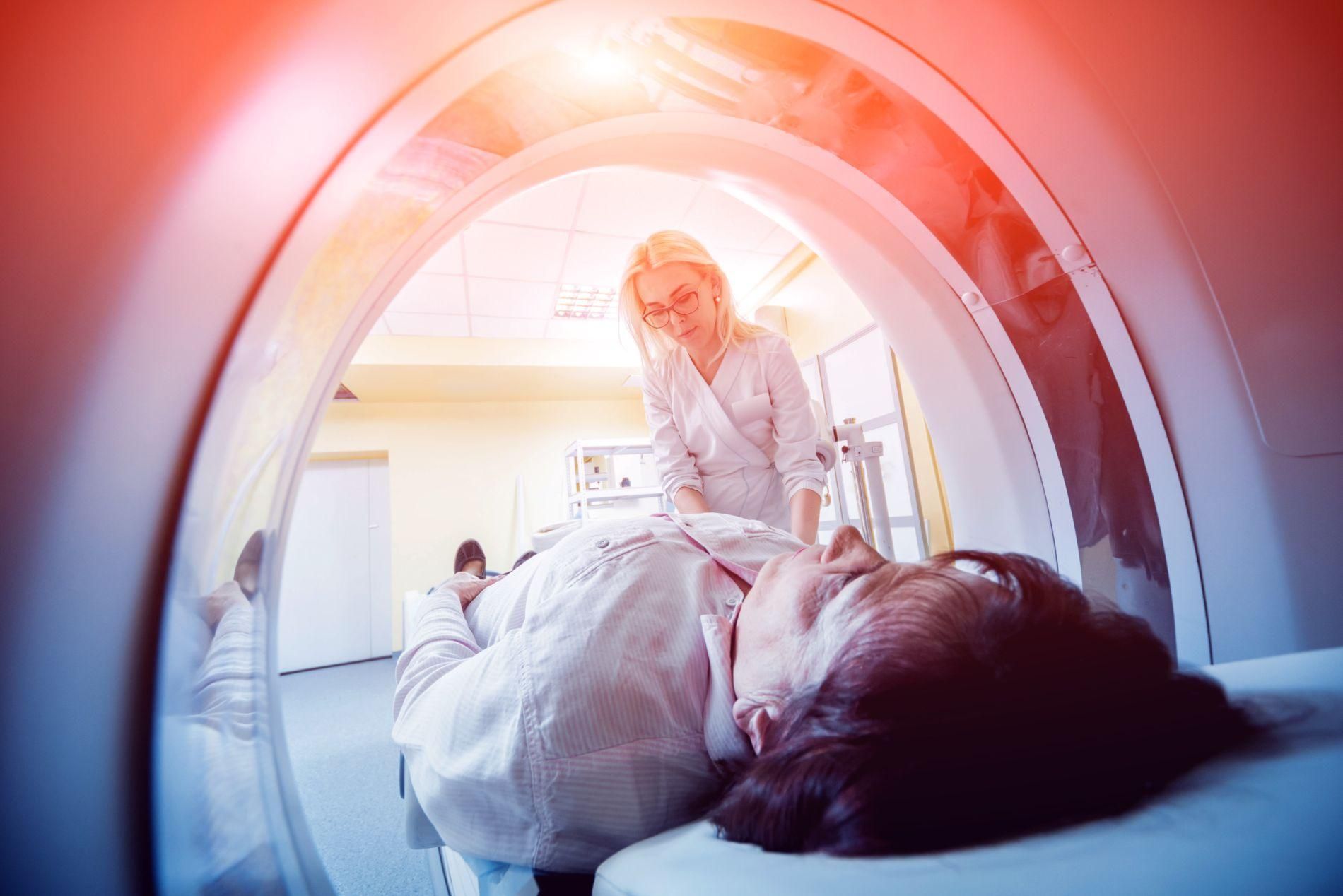Write Up: Changing Imaging Strategy During a Pandemic
)
On the 11th of March, we were proud to host Adrian Trinidade’s talk “Changing Imaging Strategy During a Pandemic” which was sponsored by Philips and included as part of our virtual Medical Imaging Convention. As the Operational Lead at Whittington Hospital, Adrian found himself in a very difficult position when a national pandemic was announced in March of 2020. Despite the very difficult and unknown territory which lied ahead, Adrian was able to revise his hospital’s imaging strategy and adapt with the times.
The site on which Whittington Hospital stands has been home to some form of hospital since the 15th century and in 1848, a new hospital was built there to deal with smallpox and vaccinations. In Adrian's own words, “I suppose you could say that dealing with infectious disease outbreaks is somewhat in our DNA”, but that doesn't mean it hasn't been challenging for them.
The imaging department at Whittington Hospital is small, dealing with diagnostic, interventional and therapeutic services. Prior to the outbreak of COVID-19, they were responsible for:
-
23,000 CT scans a year.
-
14,000 MR scans a year.
-
95,000 x-rays a year.
-
56,000 ultrasound scans a year.
Adrian describes the workload as having been not so much that it left the staff drained and stressed, but not so little that they were left twiddling their thumbs.
When the news of the pandemic broke, it took a huge toll on everybody, including Adrian. They were a relatively young team and none of them had ever faced anything like this before. In the past, they'd been trained for emergencies, but these focused on terrorist attacks and vehicular disasters, nothing quite like the situation they found themselves in.
During this time, Adrian remembers reading a lot of articles and watching a lot of webinars from other doctors to try and discover the best course of action. In the end, there were five main points to the imaging strategy that Whittington adopted:
-
Routine appointments were deferred.
-
Emergency, target and urgent services continued.
-
Staff working patterns were adjusted.
-
A local infection and control policy was developed.
-
Staff health and wellbeing remained of the utmost importance.
Deferring the routine appointments
This was a particularly difficult and labour-intensive task because Whittington Hospital had not yet gone paperless. A team of radiologists had to go over all of their referrals in order to ensure that they were only seeing people to provide lifesaving or life-changing services, anything else would be postponed. Throughout this time, they were able to maintain all maternity scans.
Due to the tight timeframe involved, an enormous number of patients had to be called within a short span of time so that they knew their appointments were cancelled. Adrian remained concerned that patients may fall through the cracks as a result of the pandemic. In order to mitigate that risk Adrian had a section for notes added to electronic patient records (EPR) so that they could keep track of those who had been unable to attend their appointment, either due to COVID-19 restrictions, or due to fear of leaving their home during a pandemic.
Adjustments to staff working patterns
In the initial outbreak, staff had to be diverted to areas where they were needed the most. This meant that A & E staff were doubled, and extra on-call staff were made available for CT and MRI scans. They were called in situations when the usual staff members had become inundated with work and when they were unable to work their usual hours due to self-isolation.
One recurring difficulty Adrian and his team experienced was that it simply wasn’t possible to have all of the staff in at the same time and maintain the proper COVID-19 safety measures. At the same time, the hospital was required to give staff the same number of working hours. What this meant was that some staff ended up having to work from home. This time was spent in one of two ways:
-
Self-development: Home working days could be spent participating in virtual training sessions, giving employees an opportunity to hone their expertise amidst the crisis.
-
Data clean-up: As Whittington Hospital prepares to go paperless, a great deal of data clean-up was and is necessary to ensure a smooth transition.
These measures helped them to reach their targets in terms of mandatory training and appraisals, while also being crucial towards the paperless transition. It was important for the team to feel proud of these victories during otherwise exceedingly challenging times.
Local Infection Control Policy
One of the most important things to do in the advent of the national pandemic was to create a Local Infection Control Policy. After being revised six or seven times, the initial draft was fifteen pages long, but Adrian was advised that this was too long and staff would not want to invest the time to read it, so it was reduced to only five pages. Feeling that too much information was lost in the five-page version, they eventually settled on a twenty-page document, consisting of the condensed version and the full version.
Though every effort was taken to consider every possible factor, Adrian admits that even now he has moments where he wonders whether things are as safe as they could be – but he is glad to have a manageable system in place.
Staff health and wellbeing
Throughout the pandemic, the staff in the imaging department have been under a lot of pressure. Adrian realised that it was essential to take every available action to maintain the health and wellbeing of his staff as much as was possible. Employees working while dealing with high levels of stress and anxiety will be unable to perform in the way that they would need to. Various measures were put in place to boost employee health and wellbeing, including:
-
A “NoVid” room in which staff could relax and unwind without hearing about the pandemic. Staff were discouraged from talking about any pandemic related subjects while in here, making it a safe space for them when they needed a break from it all.
-
To protect his own wellbeing, Adrian had to bring an end to the open-door policy which had been in place prior to the pandemic. However, to ensure that his staff were still heard, he replaced it with a sequence of drop-in sessions.
-
He took great care to ensure that his staff were not suffering from burnout and staff were encouraged to take their annual leave, even if they felt guilty about taking time off during such a difficult period.
-
Independent sector staff were brought in to help manage the workloads and there was a lot of cross-sector collaboration.
-
Stress management workshops were run on a regular basis.
Compressed Sense
Those five areas of improvement offer a brief overview of the changes Adrian had put in place to deal with the demands of the pandemic. Another aspect of his changing imaging strategy was the implementation of productivity software, most notably his use of Compressed Sense, which was used to help speed up the process of MRI scans. With the use of this software, Adrian was able to achieve the following:
-
The length of time it took to carry out an MRI scan was often cut in half, with minimal to no loss in image quality.
-
Scan times could be could down by as much as seven minutes, increasing the number of patients they could scan each day.
-
Once implemented, they saw a 30% increase in MRI capacity, helping to bring them back up to pre-pandemic levels.
-
Different protocols could then be put in place for different patients, meaning that the patients who suffered from claustrophobia would have to spend less time within the machine.
-
Patient satisfaction was improved, with many of them remarking that they were impressed with the speed in which the scans were carried out.
Compressed Sense, created by Philips, works to shorten both single MRI sequences and full MRI examinations. The process is built around the fact that signals contain redundant information, and can be used on all anatomies, creating anatomical contrasts in both 2D and 3D, while enabling spatial resolution improvements of up to 64%. You can read more about it in the supporting document linked below.
The future
Adrian brought his webinar to a close by looking to the future and considering what imaging managers’ priorities should be as we move forward. In Adrian’s opinion, these were as follows:
-
Machine learning and AI research and development.
-
Being prepared for any future pandemics which may occur.
-
To invest more in staff.
-
To ensure the wellbeing of all employees.
We hope you’ve enjoyed reading this summary of Adrian’s talk. If you would like to see Adrian’s webinar in full, including lots of extra facts, details, and figures, plus a Q & A session which was held afterwards, it’s still available to watch in its entirety until the 11th of April via our on-demand service. Watch it now while it’s still available!


